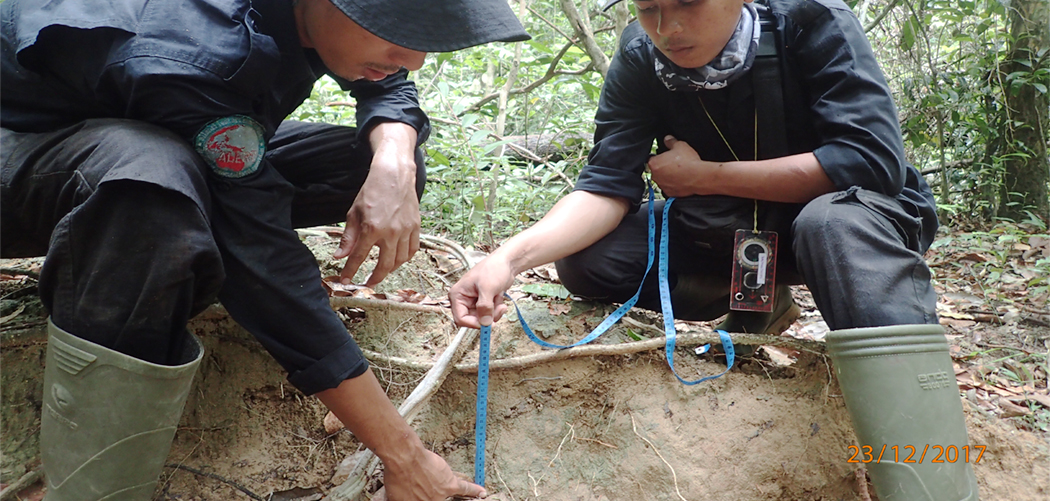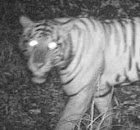
The population and habitat of the Sumatran rhinoceros (Dicerorhinus sumatrensis) has been in decline for 50 years. The Indonesian Ministry of Forestry (2015) estimates only 100 Sumatran rhinoceros individuals remaining in their natural habitat. However, there is no confirmed, accurate data on the population or other supporting data that describes actual conditions in the wild. In order to make effective and efficient recommendations for conservation actions, accurate and valid data is urgently required. This data would include factors such as population, distribution and sex ratio.
 The Sumatran Rhino Occupancy Survey was conducted over an area of 195 grids, each measuring 2 x 2km, with a canopy coverage of 30% or more. As of January 2018, the RMU's have successfully surveyed 181 grids. During survey activities, the RMU team identified the signs of rhino activities, such as footprints and foot rubs in / on soil, dung, feed, twisting of plants, urine, body rubs on trees, and wallows in several grid areas in SPTN I, II, and III. These are the ruins of Sumatran rhino. The data gathered so far directs future camera trap monitoring, by providing specific locations of the secondary signs. With camera trap footage, these secondary signs can transition into primary signs, documenting the active pathways of the Sumatran rhino within WKNP. In addition to the rhinoceros, the RMU teams have also collected secondary signs from other key species, such as Sumatran tigers, Sumatran elephants, sun bears, and Malayan tapir. Alongside documenting data of rhino and other wildlife, the RMU teams also encountered signs of illegal activity within WKNP.
The Sumatran Rhino Occupancy Survey was conducted over an area of 195 grids, each measuring 2 x 2km, with a canopy coverage of 30% or more. As of January 2018, the RMU's have successfully surveyed 181 grids. During survey activities, the RMU team identified the signs of rhino activities, such as footprints and foot rubs in / on soil, dung, feed, twisting of plants, urine, body rubs on trees, and wallows in several grid areas in SPTN I, II, and III. These are the ruins of Sumatran rhino. The data gathered so far directs future camera trap monitoring, by providing specific locations of the secondary signs. With camera trap footage, these secondary signs can transition into primary signs, documenting the active pathways of the Sumatran rhino within WKNP. In addition to the rhinoceros, the RMU teams have also collected secondary signs from other key species, such as Sumatran tigers, Sumatran elephants, sun bears, and Malayan tapir. Alongside documenting data of rhino and other wildlife, the RMU teams also encountered signs of illegal activity within WKNP. Human activity in the area of WKNP is still a major threat to the conservation of Sumatran rhinoceros and other wildlife. Most of the illegal activities were found in the rhino's active pathways. These illegal activities range from low threat to high threat, encompassing crimes of poaching (snare traps), illegal logging, illegal boating and fishing, illegal camping and illegal burning of the forest. These activities are threats not only to the Sumatran rhino, but to the broader ecosystem of WKNP.
Human activity in the area of WKNP is still a major threat to the conservation of Sumatran rhinoceros and other wildlife. Most of the illegal activities were found in the rhino's active pathways. These illegal activities range from low threat to high threat, encompassing crimes of poaching (snare traps), illegal logging, illegal boating and fishing, illegal camping and illegal burning of the forest. These activities are threats not only to the Sumatran rhino, but to the broader ecosystem of WKNP.








































 Enjoy the Way Kambas National Park endangered mega fauna and other rare wildlife species caught in video. Find mother and baby of Sumatran rhino, challenging young male Sumatran tiger, big family of Sumatran elephant, funny Malayan sun-bear and curious Malayan tapir.
Enjoy the Way Kambas National Park endangered mega fauna and other rare wildlife species caught in video. Find mother and baby of Sumatran rhino, challenging young male Sumatran tiger, big family of Sumatran elephant, funny Malayan sun-bear and curious Malayan tapir. It was written by Janos Olah & Attila Simay in Birding Asia magazine, on 2007. Not only the great variety of the otherwise scarce and hard to-come-by species is what makes this national park world-famous, but also the relative ease in finding them. No other place in sumatra that has 4 species of Frogmouth.
It was written by Janos Olah & Attila Simay in Birding Asia magazine, on 2007. Not only the great variety of the otherwise scarce and hard to-come-by species is what makes this national park world-famous, but also the relative ease in finding them. No other place in sumatra that has 4 species of Frogmouth.


0 komentar :
Post a Comment
Berikan saran atau kritik yang membangun untuk website ini
Terimakasih